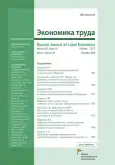Distance employment: characteristics and development in Russian economy
- Authors: Zabelina O.V.1, Mirzabalaeva F.I.2,1
-
Affiliations:
- Federal State Budgetary Institution “All-Russian Scientific Research Institute of Labor” of the Ministry of Labour and Social Protection of the Russian Federation
- Plekhanov Russian University of Economics
- Issue: Vol 10, No 10 (2023)
- Pages: 1553-1568
- Section: Articles
- URL: https://journals.eco-vector.com/2410-1613/article/view/625110
- DOI: https://doi.org/10.18334/et.10.10.119263
- ID: 625110
Cite item
Abstract
Distance employment as a consequence of the digitalization of the sphere of work attracts the attention of a wide range of researchers both in Russia and abroad. At the same time, there are still many unresolved problems, including those concerning the criteria for identifying this new form of employment, the categorical apparatus used to describe it (remote work, telework, and distance employment), structuring the heterogeneous sphere of remote employment, etc. The purpose of this study is to identify the features and characteristics of the development of distance employment in the modern Russian economy. The authors of the article, based on Rosstat data, give an expert assessment of the change in the scale of population involvement in remote employment, identify the characteristics of remote workers based on the analysis of their age, educational, professional structure (with a gender and settlement aspect). The analysis allowed the authors not only to form a socio-demographic portrait of a remote employee, but also to emphasize the methodological problems of identification by Rosstat of remote employment in the Labor Force Survey.The results of the study can be used by the executive authorities of the federal and regional levels in the preparation of proposals in the field of regulation of distance employment. The information base of the study was regulatory documents, the works of Russian and foreign experts, as well as data from the Rosstat surveys of workforce for 2014-2022.
About the authors
Olga Viktorovna Zabelina
Federal State Budgetary Institution “All-Russian Scientific Research Institute of Labor” of the Ministry of Labour and Social Protection of the Russian Federation
Email: Zabelina_OV@vcot.info
Farida Islamudinovna Mirzabalaeva
Plekhanov Russian University of Economics; Federal State Budgetary Institution “All-Russian Scientific Research Institute of Labor” of the Ministry of Labour and Social Protection of the Russian Federation
Email: faridamir@yandex.ru
References
- Брюхина Е. Р. Дистанционная (удаленная) работа как цифровой сегмент рынка труда: проблемы и перспективы // Вестник воронежского государственного университета. серия: право. – 2021. – № 1. – c. 80-89.
- Гурова И. М. Дистанционная работа как тренд времени: результаты массового опыта // МИР (Модернизация. Инновации. Развитие). – 2020. – № 2. – c. 128–147.
- Жидяева Е. С., Кувалдина Е. А. Преимущества и недостатки удаленной работы // Международный журнал гуманитарных и естественных наук. – 2021. – № 4-3 (55). – c. 10–14.
- Закалюжная Н.В. Дистанционная работа и схожие правоотношения // Право. Журнал Высшей школы экономики. – 2015. – № 2. – c. 78–81.
- Итоги выборочного обследования рабочей силы. Росстат. [Электронный ресурс]. URL: https://rosstat.gov.ru/folder/11110/document/13265 (дата обращения: 10.09.2023).
- Кожевников О.А., Чудиновских М.В. Регулирование труда дистанционных работниковв России и за рубежом // Вестник Санкт-Петербургского университета. Серия 14. Право. – 2020. – № 3. – c. 563-583.
- Конобевцев Ф. Д., Лаас Н. И., Гурова Е. В., Романова И. А. Удаленная работа: технологии и опыт организации // Вестник университета. – 2021. – № 7. – c. 9–17.
- Локтюхина Н.В., Черных Е.А. Качество трудовой жизни удалённых работников: методологические подходы и первые оценки по ЕС и России // Уровень жизни населения регионов России. – 2021. – № 1. – c. 42–56. – doi: 10.19181/lsprr.2021.17.1.4.
- Малышев А. А. Эволюция практики удаленной работы в России и за рубежом // Вестник Сибирского института бизнеса и информационных технологий. – 2018. – № 3(27). – c. 33–40.
- Нагапетян К.В., Озерникова Т.Г. Опыт организации удаленной работы в условиях пандемии и перспективы его дальнейшего использования // Экономика труда. – 2021. – № 2. – c. 201-218. – doi: 10.18334/et.8.2.111779.
- Орлов В. Б., Бураншина Е. И. Удаленная работа как новая реалия трудовых отношений: анализ факторов предрасположенности к удаленной работе // Вестник Югорского государственного университета. – 2014. – № 4(35). – c. 40–46.
- Плотников А.В., Брагина Д.С. Удаленная работа в условиях пандемии и влияние самозанятости на теневую экономику // Московский экономический журнал. – 2021. – № 5. – c. 238–254.
- Разумова Т.О., Янчук О.Ю. Возможности и риски дистанционных форм занятости для студентов и выпускников высших учебных заведений // Социально-трудовые исследования. – 2021. – № 43(2). – c. 85-98. – doi: 10.34022/2658-3712-2021-43-2-85-98.
- Стребков Д.О., Шевчук А.В., Спирина М.О. Развитие русскоязычного рынка удаленной работы, 2009–2014 гг. (по результатам Переписи фрилансеров) [. / Нац. исслед. ун-т «Высшая школа экономики»; Лаб. экон.-социол. исслед. - М.: Изд. дом Высшей школы экономики, 2015. – 225 c.
- Федченко А.А. Удаленная работа в условиях использования цифровых технологий: перспективы трансформации // Экономика труда. – 2021. – № 4. – c. 377-390.
- Цыганкова И.В. Социальные аспекты применения нестандартных форм занятости на российском рынке труда // Российский научный журнал «Телескоп: журнал социологических и маркетинговых исследований». – 2022. – № 1(5). – c. 116-117.
- Eurofound and the International Labour Office (2017), Working anytime, anywhere: The effects on the world of work, Publications Office of the European Union, Luxembourg, and the International Labour Office, Geneva
- Eurofound (2021), Right to disconnect: Exploring company practices, Publications Office of the European Union, Luxembourg
- Yang L., Holtz D., Jaffe S. The effects of remote work on collaboration among information workers. Nat Hum Behav (2021). [Электронный ресурс]. URL: https://www.nature.com/articles/s41562-021-01196-4.pdf (дата обращения: 15.09.2023).
Supplementary files











